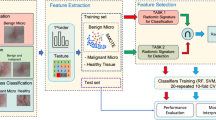Abstract
Several computer-aided testing tools have been developed more than ever in breast cancer research to minimize misdiagnosis. In this paper, a data mining method has been discussed that could help oncologists identify and detect breast cancer. Including microcalcifications, masses, and even regular findings from tissue was used as a stable database of 410 images. Two extraction techniques have been applied, particularly the unit for gray standard and length of the gray level unit. Many data mining classifications were also used for classification purposes. The findings were shown to be very favorable (roughly 70%) in terms of mammogram separation and BI-RADS® scale (>75%) with acceptable reliability and functional precision. The classification of random forest was the best predictive method to distinguish microcalcification with excellent performance.
Access this chapter
Tax calculation will be finalised at checkout
Purchases are for personal use only
Similar content being viewed by others
References
Bray F, Ren JS, Masuyer E, Ferlay J (2013) Global estimates of cancer prevalence for 27 sites in the adult population in 2008. Worldwide J Cancer 132(5):1133–1145
The clinical concept of Robbins and Cotran Kumar illness, V., Abbas, A.K., Fausto, N., Aster and J. Pathologists of Kumar, Technical edition, Master Consult-Online, Well-being Elsevier Sciences (2009)
O.M., Modzhtabai, A. International Wellbeing Association (2006) Early assessment and review instructions for small breast cancer. EMRO Specialized Supply Arrangement, vol 30
Breast cancer. Wellbeing. PubMed Wellbeing (2012): ADAM Therapeutic Guide Book
AC Group. American Cancer Society: Recommendations on breast cancer 2013 point by point
Breast cancer screening (2009) Recommendation 151(10):716. R/Breast cancer/
S.: Composition and susceptibility of Breast Minkin, National Institute for Cancer Journal, Tissues Boyd, N.f., Martin, L.J., Bronskill, M., yaffe, M.J., Duric, N. (2010)
Wang AT, Ghosh AT, Vachon CM (eds) (2014) Chance of breast and breast cancer: study of common sense. Mayo Clinic procedures
Gierach GL, Ichikawa L, Gierach L, Brinton LA, Farhat GN, Vacek PM et al (2012) Mammographical Thickness Consortie’s relationship between mammographic thickness and breast cancer
ACO Radiation. ACR BI-RADS® Map Book. American Radiological School. http://www.acr.org/quality-safety/reports/BIRADS. 2 Feb 2014
Cubas MR, Paraíso EC (2010) Report of National Cancer. Classified micro-areas which use mining information. Rev Saúde Pública 44(2):292–300
Cardos MJ, Moreira IC, Amaral I, Domingues A(2012) INBreast: a computerized mammographic fullfield database. Wissenschaftliche Radiol 19(2):236–248
Mammography research: breast density identification (2013) MSc Paper, Porto University. Teixeira, R.: Mammography Research Programmed
Curi JS, Wilson DL, Laxminarayan (1997) Bioanalytic manual. Dublin
For funding. Carneiro P. Review of mamma mass strength and stiffness characteristics
Meselhy EM, Faye I, SB (2012) Multi-resolution representation technique for the highlight retrieval of highlight for breast cancer interpretation. Sci Med Comput 42(1):123–128
Beberta S, Lenke Mohanty AK, S (2012) The highlights of the mammograms of choice. Recital23 (3‐4), 1011–1017
Menegatti E, GhidoniS, Nanni L, Brahnam ST (2013) The grid of coincidence differentiating methods for data collection. PLoS 13:e83554
Deals I, Sunday E, et al Mass characterization of InBreast Server. CBEB XXIII
Da Fonseca JL, Cardose JS, Sunday I (2013) Breast cancer PreCADs. Pension 2(3)
Boyd NF, Martin LJ, Yaffe Mj, Minkin S (2011) Current understanding and prospects for breast thickening and breast cancer chance. Breast Cancer Study 13(6):223
L., C.-H., L.-F. Logics World Pau, Wang PS (2010) Recognition and perception manual implementations 23(3–4)
Pradeep Ghantasala GS, KrishnaRaj N (2015) A survey on microcalcification identification and classification using CAD system. J Emerg Technol Innov Res (JETIR) 2(5):186–190
Pradeep Ghantasala GS, KrishnaRaj N (2016) Support vector machine based automatic mammogram classification using hybrid optimization algorithm. Int J Res Eng IT Soc Sci 6(9):50–54. ISSN 2250-0588
Author information
Authors and Affiliations
Corresponding author
Editor information
Editors and Affiliations
Rights and permissions
Copyright information
© 2021 The Author(s), under exclusive license to Springer Nature Singapore Pte Ltd.
About this paper
Cite this paper
Bhowmik, C., Pradeep Ghantasala, G.S., AnuRadha, R. (2021). A Comparison of Various Data Mining Algorithms to Distinguish Mammogram Calcification Using Computer-Aided Testing Tools. In: Goyal, D., Gupta, A.K., Piuri, V., Ganzha, M., Paprzycki, M. (eds) Proceedings of the Second International Conference on Information Management and Machine Intelligence. Lecture Notes in Networks and Systems, vol 166. Springer, Singapore. https://doi.org/10.1007/978-981-15-9689-6_58
Download citation
DOI: https://doi.org/10.1007/978-981-15-9689-6_58
Published:
Publisher Name: Springer, Singapore
Print ISBN: 978-981-15-9688-9
Online ISBN: 978-981-15-9689-6
eBook Packages: Intelligent Technologies and RoboticsIntelligent Technologies and Robotics (R0)




